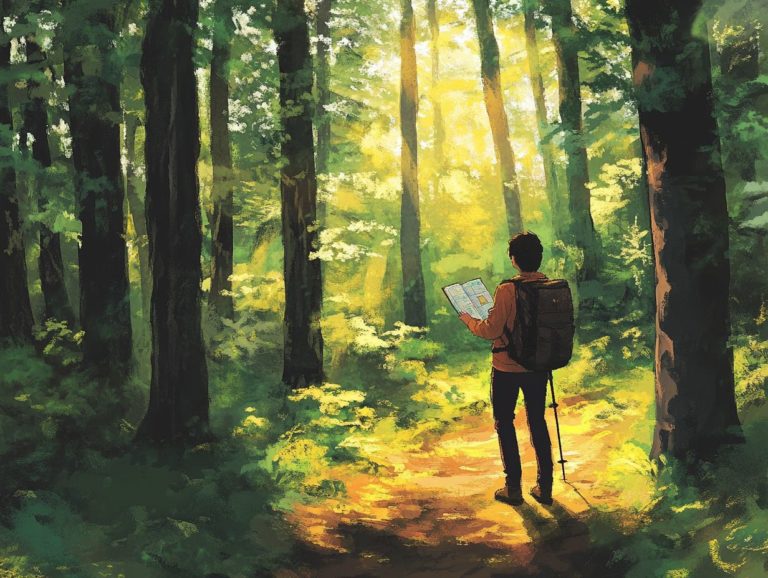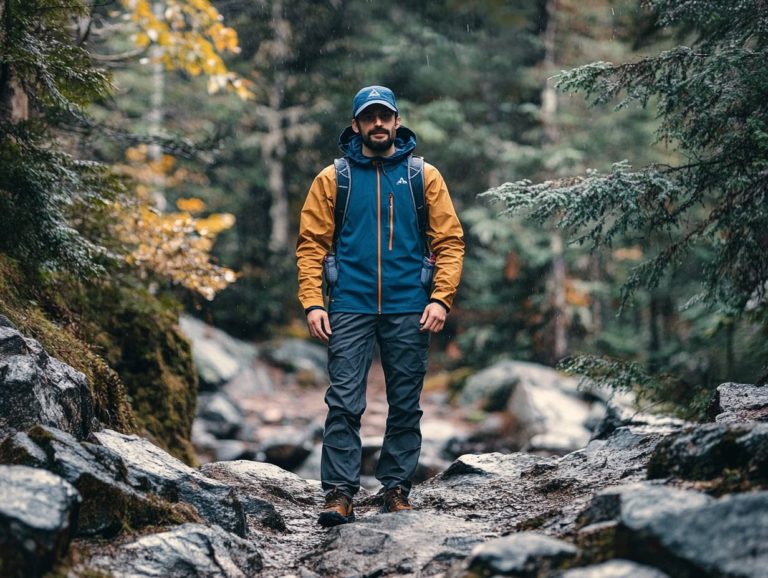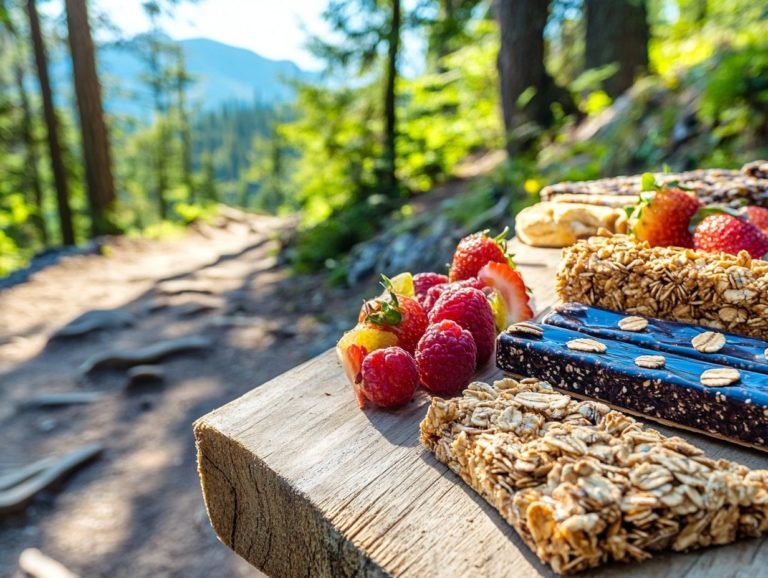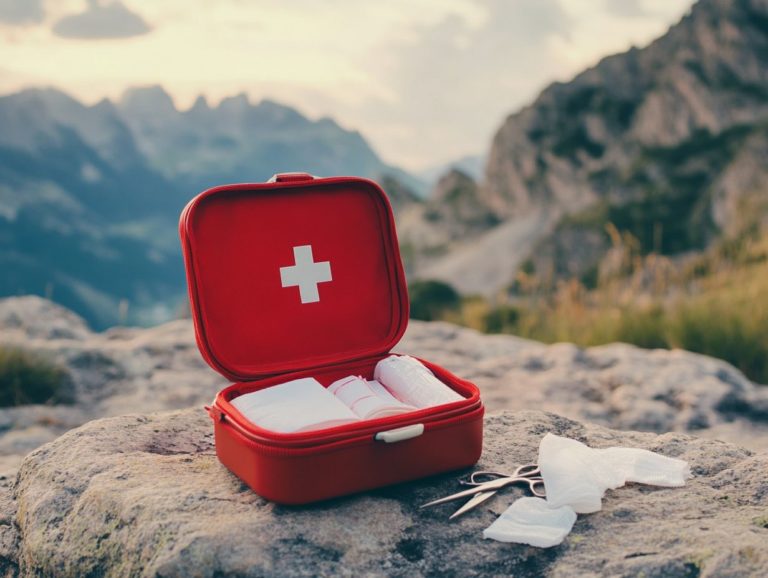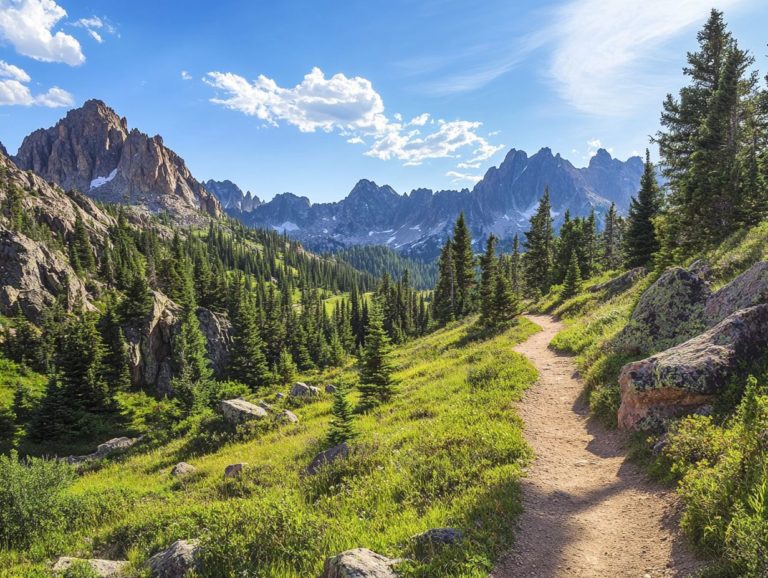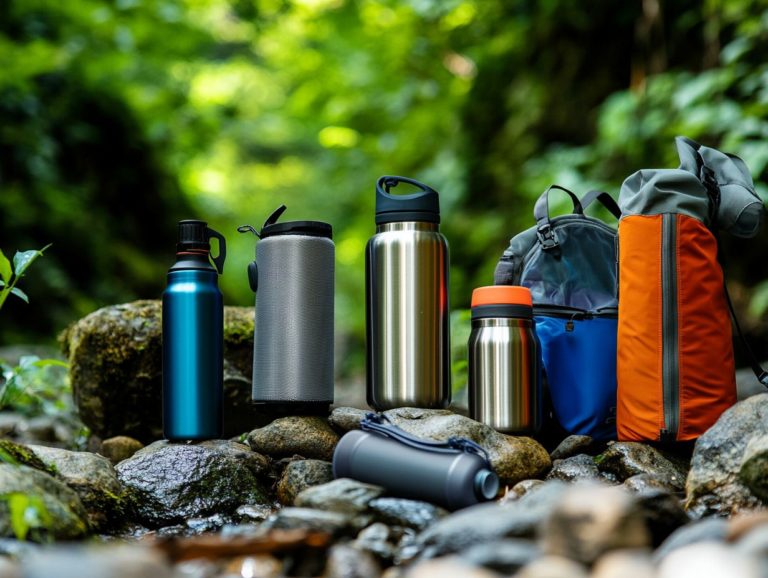How to Build a Hiking Survival Kit
When you venture into the wilderness, meticulous preparation is crucial for ensuring a safe and enjoyable experience. A thoughtfully curated hiking survival kit can mean the difference between a minor inconvenience and a significant crisis.
Consider including essential items in your kit, ranging from selecting the perfect backpack to packing extra batteries and a lightweight flashlight.
Whether you’re an experienced hiker or just starting out, these tips will help you feel more confident in the great outdoors, equipping you with vital outdoor survival skills.
Contents
- Key Takeaways:
- 1. Choose the Right Backpack
- 2. Pack Enough Food and Water
- 3. Bring a Map and Compass
- 4. Pack a First Aid Kit
- 5. Bring a Shelter and Warm Clothing
- 6. Pack a Multi-Tool
- 7. Bring a Fire Starter
- 8. Pack Extra Batteries and a Flashlight
- 9. Bring a Whistle and Signal Mirror
- 10. Pack a Water Filtration System and Other Essential Items
- 11. Bring a Knife
- 12. Pack Sun Protection
- 13. Bring Insect Repellent
- 14. Pack Personal Items and Medications
- 15. Bring a Fully Charged Cell Phone and Emergency Contact Information
- What Are the Essential Items for a Hiking Survival Kit?
- Frequently Asked Questions
- What items should I include in my hiking survival kit?
- How much water should I pack in my hiking survival kit?
- Should I pack food in my hiking survival kit?
- What should I consider when choosing a first aid kit for my hiking survival kit?
- Can I use my phone as a navigation tool in my hiking survival kit?
- Do I need to pack different items for different types of hikes in my survival kit?
Key Takeaways:
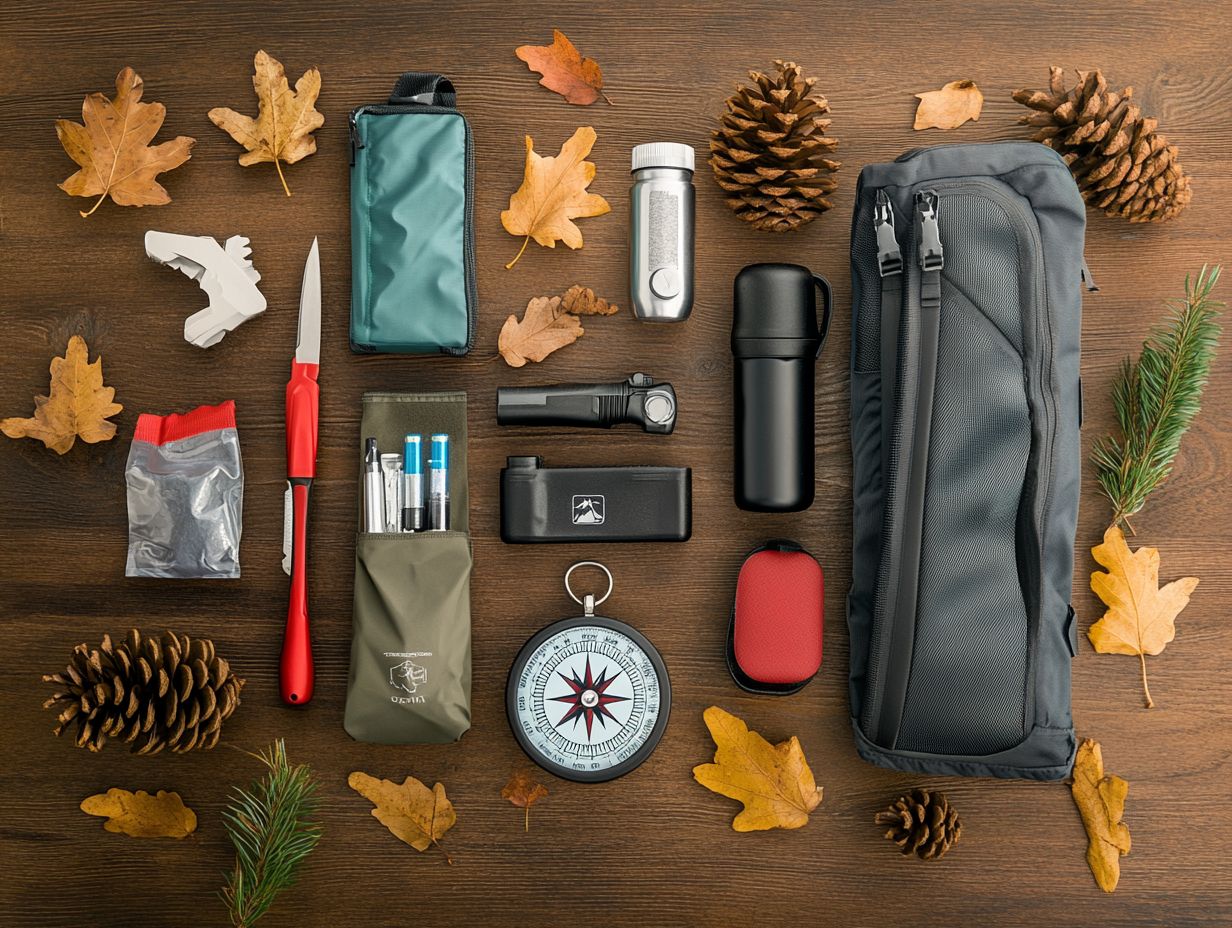
- Choose the right backpack that is comfortable and fits well to carry all essential items.
- Pack enough food and water to sustain energy and stay hydrated during the hike, including water purification tablets that help clean water from natural sources.
- Bring a map and compass to navigate and avoid getting lost while hiking.
1. Choose the Right Backpack
Picking the right backpack can make or break your hiking adventure! It s not just about fitting in a survival kit; it s about ensuring your comfort and functionality as you navigate challenging terrains, whether you re conquering the Himalayas, trekking through the Sahara, or exploring the rugged Yukon and the Darien Gap.
With a wide range of sizes and weight distribution options available, selecting the right backpack can significantly impact how easily you traverse diverse landscapes. Thoughtful compartments allow you to organize your gear efficiently, accommodating various conditions and personal preferences.
Brands like Montem Trekking Poles provide trekking poles that enhance your stability on rugged paths, while CamelBak offers advanced hydration systems to keep you refreshed without the burden of extra weight. These features can elevate your hiking experience, transforming potential challenges into memorable explorations.
2. Pack Enough Food and Water
Packing enough food and water is crucial for your hiking trip. Your survival kit should definitely include water purification tablets to ensure safe drinking water and a reliable backpack hydration system for convenience.
Choosing the right types of food can significantly impact your energy levels and overall experience. Consider packing first aid kits and emergency hand warmers for unexpected situations. For instance, energy bars provide a compact source of calories and nutrients, while dehydrated meals are lightweight and easy to prepare on the go.
It’s also crucial to prioritize hydration, as many trekkers overlook the necessity of staying well-hydrated for maintaining stamina. That s where water purification tablets become invaluable, allowing you to safely treat water from streams or lakes, ensuring a dependable supply without the burden of carrying bottled water.
3. Bring a Map and Compass
Including a map and compass in your survival kit is absolutely essential. These time-honored navigation tools give you the skills needed to safely navigate your hiking expeditions without being reliant on electronic devices.
In a world where GPS and smartphones dominate navigation, mastering outdoor survival skills is vital for anyone who truly cherishes nature. Imagine being deep in the wilderness, devoid of cell service and with a dead battery. Relying solely on technology can easily lead to disorientation and potential danger.
Traditional tools like maps and compasses foster a deeper connection to your surroundings, empowering you to make informed decisions even in the toughest situations. By sharpening these skills, you not only enhance your safety but also cultivate a richer appreciation for nature, turning every adventure into a more gratifying experience.
Start packing your hiking survival kit today and get ready for your next adventure!
4. Pack a First Aid Kit
Packing a comprehensive first aid kit is essential for you as an outdoor enthusiast. It equips you with the necessary tools to tackle injuries, manage emergencies, and ensure your safety during hikes especially in remote areas like the Coronado National Memorial or the Yukon.
A well-stocked kit should include:
- Bandages of various sizes
- Antiseptic wipes or ointments to ward off infection
- Gauze rolls for those larger wounds
- Emergency hand warmers, lifesavers when the temperatures drop
- Tweezers, critical for removing splinters or ticks
Don t forget to include pain relief medications, first aid kits, and a sterile saline solution for rinsing cuts to ensure comprehensive care.
If you’re eager to elevate your skills, the Wilderness Medicine Training Center offers valuable resources and courses, giving you the power to handle medical situations with confidence in challenging environments.
5. Bring a Shelter and Warm Clothing
Bringing a reliable shelter and warm clothing is absolutely essential for your outdoor survival. This preparation ensures you’re ready for unexpected weather changes and can maintain your body heat, especially in extreme environments like the Himalayas, Sahara, or the Yukon.
Choosing the right type of shelter is crucial. For instance, lightweight tents are perfect for mountainous regions where fierce winds can threaten your comfort, while tarps might suffice in milder climates.
Layer your clothing to improve insulation. Consider adding space blankets for additional warmth and protection. Start with moisture-wicking base layers and top them with warmer mid and outer garments for maximum effectiveness.
In emergency situations, adding space blankets to your gear can be a game-changer. These compact wonders not only help retain heat but also reflect warmth back to your body, making them a critical part of your survival kit alongside waterproof matches and a fire starter.
6. Pack a Multi-Tool
Packing a reliable multi-tool can truly transform your outdoor experience, offering a multitude of functionalities from cutting and repairing to different survival tasks making it an essential addition to your hiking survival kit.
By opting for a compact design that combines multiple tools, like those from esteemed brands such as Leatherman or Smith & Wesson, you can conserve valuable space and weight in your backpack. Instead of dragging around separate items like pliers, screwdrivers, and knives, a single high-quality multi-tool can effortlessly tackle all these tasks, fitting snugly in your pocket.
This enhances your mobility during treks and ensures you’re equipped for unexpected challenges, making it an critical companion whether you’re a weekend adventurer or a seasoned explorer. Make sure to pack your multi-tool before your next adventure!
7. Bring a Fire Starter
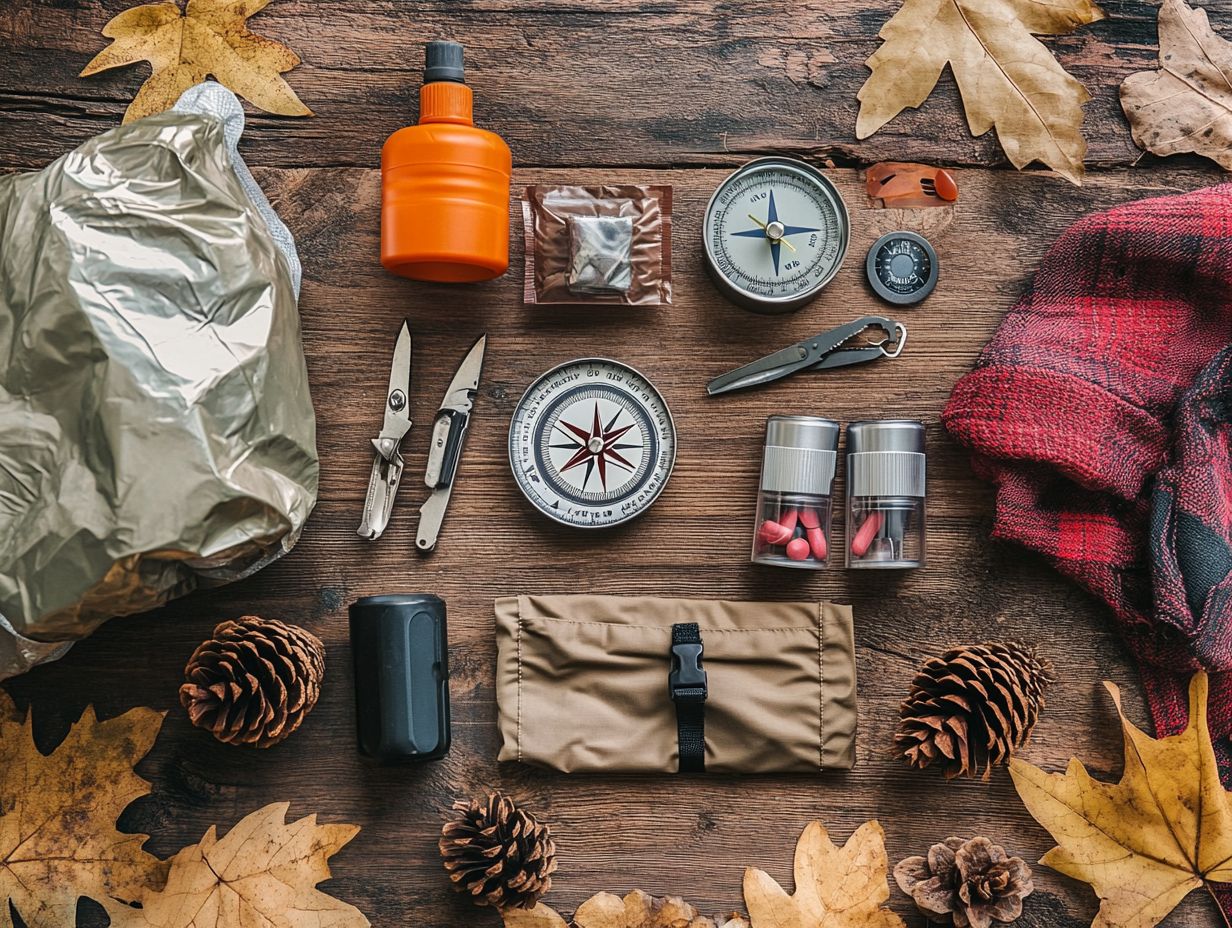
Bringing along a reliable fire starter and waterproof matches is essential for your outdoor survival, ensuring you can generate warmth and prepare meals on your hiking adventures, no matter the weather conditions.
Incorporating tools like magnesium blocks blocks that produce sparks when scraped or flint and steel can significantly boost your chances of successfully igniting a fire. Fire is a game-changer in the wilderness, serving multiple critical purposes.
- It provides warmth in chilly environments, helping to stave off hypothermia.
- The ability to cook meals not only enhances flavor but also eliminates harmful pathogens.
- A well-maintained fire can serve as a signal for rescue, offering vital visibility in remote areas.
This makes mastering various fire-starting techniques an critical skill for any outdoor enthusiast.
8. Pack Extra Batteries and a Flashlight
Packing extra batteries and a lightweight flashlight is a must-have in your survival kit to keep you safe. These items guarantee you re safe and visible when darkness falls!
For hikers, selecting the right flashlight can truly elevate your outdoor experiences, especially when navigating unfamiliar trails. Tactical flashlights are particularly noteworthy. These are durable, bright, and versatile, making them an excellent choice for various conditions.
When choosing a lightweight flashlight, consider its lumens a measure of brightness and whether you prefer a tactical flashlight for added durability. A higher brightness can light up expansive areas or distant objects, but you ll want to balance that with battery life to avoid frustrating replacements. Consider keeping an Energizer stash of extra batteries in your pack.
Having extra batteries guarantees that light is always at your fingertips, emphasizing the importance of preparedness on every outdoor excursion.
9. Bring a Whistle and Signal Mirror
Including a communication device like a whistle and a signal mirror in your survival kit can be lifesaving. These devices significantly enhance your ability to call for help when you’re hiking in remote areas.
Understanding how sound travels and what s visible is vital. A whistle carries sound over impressive distances, even in challenging landscapes, effectively alerting rescuers to your location. A signal mirror reflects sunlight, producing a flash that can be seen from miles away, especially on clear days.
To harness these tools effectively, practice blowing the whistle in short bursts to create a distinct sound pattern. Use your signal mirror wisely to maximize its reflective power. Make sure the mirror is clean and angled correctly toward the sun to enhance its signal. By combining these techniques with fire starters and waterproof matches, you boost your chances of being seen and heard in critical moments.
10. Pack a Water Filtration System and Other Essential Items
Packing a reliable water filtration system is essential for you as a hiker. This allows you to safely drink from natural water sources and ensures hydration and safety during extended hiking trips in remote terrains like the Darien Gap or Arizona.
With a variety of options at your fingertips, you can choose from:
- Portable straw filters to sip directly from streams
- Comprehensive pump systems that purify an entire liter in one go
- Lightweight UV purifiers that use ultraviolet light to eliminate bacteria and viruses, making them particularly appealing in backcountry settings
For a straightforward approach, water purification tablets are an excellent backup. They easily dissolve in water to provide safe drinking options when you find yourself in a pinch.
Understanding these systems enhances your hiking experience and highlights the importance of staying hydrated without compromising your health.
11. Bring a Knife
A survival knife is an essential tool for any outdoor enthusiast like you. It offers a range of functionalities, from cutting and food preparation to self-defense. You ll definitely want this in your kit!
When selecting a survival knife, you ll find a vast array of options tailored to meet various needs in the wilderness. For example, fixed-blade knives are celebrated for their strength and durability, perfect for heavy-duty tasks like batoning wood or skinning game. In contrast, folding knives offer the advantage of portability, easily slipping into your pocket for convenient everyday carry.
A reliable survival knife also serves multiple purposes in your survival gear. You might encounter knives with specialized features, such as serrated edges for cutting rope or integrated fire starters for igniting a blaze. A quality knife boosts your efficiency in outdoor survival situations and ensures reliability when the going gets tough.
12. Pack Sun Protection
Don t forget to pack sun protection! It s vital for your outdoor adventures, especially when navigating the Himalayas or the Sahara. Prolonged exposure to UV rays can lead to serious health risks. Sunscreen and protective clothing should be non-negotiable items in your hiking survival kit.
When you venture into various environments be it sunny trails, alpine terrains, or coastal paths selecting the right sunscreen is crucial. Lightweight flashlights and fire starters can also enhance your outdoor experience. This is especially important at higher altitudes, where UV exposure intensifies. Wide-brimmed hats and lightweight, UV-blocking clothing offer significant barriers against the sun’s harmful effects.
Being mindful of these factors not only protects your skin but also improves your overall hiking experience by keeping fatigue and heat-related issues at bay. Neglecting sun protection can result in painful sunburns or more severe conditions. Awareness and preparation are key to fully enjoying your outdoor explorations!
13. Bring Insect Repellent
Including insect repellent in your survival kit is essential for outdoor enthusiasts. It shields against bites and diseases carried by insects. This enhances both your safety and enjoyment during hiking trips!
You have several options for insect repellents, including DEET, picaridin, and natural alternatives like citronella. Each offers varying effectiveness depending on the environment and season. For instance, DEET is a common bug spray that s very effective against mosquitoes and ticks, making it a go-to choice in wooded or marshy areas during warmer months.
If you prefer comfort, choose a repellent with picaridin for long-lasting protection without the oily residue. Natural repellents may appeal to environmentally conscious hikers but typically require more frequent applications.
No matter which type you choose, knowing how and when to apply these repellents will significantly elevate your experience. This way, you can immerse yourself in the adventure without worrying about insect encounters!
14. Pack Personal Items and Medications
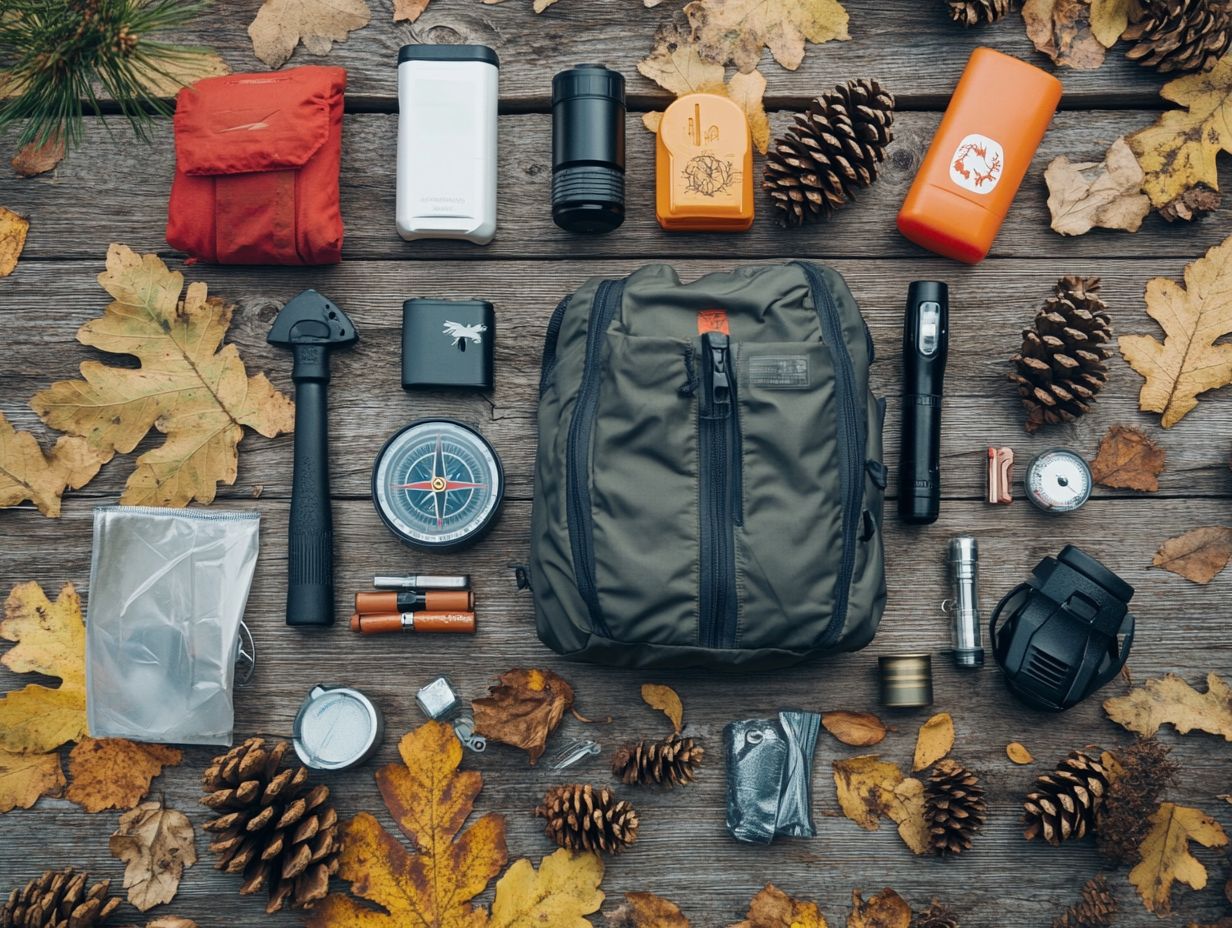
Packing your personal items and medications is crucial yet often overlooked. Ensuring you have all necessary prescriptions and comfort items can greatly enhance your outdoor experience and boost your safety.
Having an ample supply of personal medications helps you avoid potential health complications while exploring. It s also vital to include items like identification, emergency contact information, and a first aid kit. These can prove invaluable in unexpected situations.
By incorporating a well-stocked first aid kit, you ll be ready to address any health concerns that may arise while navigating rugged terrain. This not only gives you peace of mind but also increases your preparedness, ensuring you can handle minor injuries and medical emergencies confidently.
15. Bring a Fully Charged Cell Phone and Emergency Contact Information
Bringing a fully charged cell phone and having emergency contact information is essential for your outdoor survival. It significantly enhances your ability to communicate during emergencies, providing access to crucial navigation tools and resources.
Before heading outdoors, ensure your phone is fully charged and consider bringing portable chargers. This preparation serves as a lifeline in unexpected situations and gives you the power to access vital information at your fingertips.
Consider incorporating portable chargers; they can be a game-changer, extending your device’s usability during longer excursions. It s also wise to compile a comprehensive list of emergency contacts, including local authorities and those who should know your plans.
Make sure to share these plans with a trusted friend. This adds an extra layer of safety, ensuring someone knows your whereabouts while you enjoy your adventure!
What Are the Essential Items for a Hiking Survival Kit?
A well-prepared hiking survival kit is an essential companion for outdoor enthusiasts like you. It ensures safety and readiness when unexpected challenges arise on the trail.
This kit includes crucial gear and skills for different scenarios. Preparation can make all the difference, such as knowing about treating altitude sickness.
Think of this kit as your lifeline in emergencies, packed with an array of tools and supplies that can significantly boost your chances of survival in the wilderness. Among the most critical components is a reliable hydration source, be it a water filter, water purification tablets, or backpack hydration systems ensuring you always have access to safe drinking water. Additionally, knowing how to use hiking gear for survival can enhance your preparedness in the wild.
Don’t underestimate the importance of high-energy snacks, portable food options, and emergency hand warmers; they’re vital for keeping your energy levels up during those strenuous hikes. Additionally, you should consider what to include in your survival gear kit by including essential tools like a multi-tool, a fire starter, and a map or GPS device to navigate your way and complete necessary tasks.
And let s not forget first aid supplies bandages, antiseptics, and pain relievers are critical for treating any injuries that may occur. Check and update your kit regularly to keep it ready for whatever adventure awaits you!
What Are Some Additional Items to Consider Packing?
When you’re gearing up for a hiking trip, considering some extra items like space blankets and waterproof matches can truly elevate your outdoor experience. These additions enhance your survival gear beyond just the essentials.
For instance, adding emergency blankets to your pack can provide much-needed warmth when the weather takes an unexpected turn. Stocking up on additional batteries can protect you from the frustration of devices losing power, allowing you to navigate and communicate without a hitch. Additionally, consider including the best survival gear for day hikes to enhance your readiness for any situation.
Let’s not forget portable chargers, which are invaluable for keeping your essential gadgets running smoothly during longer treks. These clever additions, like duct tape for quick fixes, boost your security and make your adventure more enjoyable! For a comprehensive list of must-have items, check out the top 10 survival gear items for hikers. Pack smart and hike happy!
How Can a Hiker Prepare for Different Weather Conditions?
Preparing for various weather conditions is crucial for your outdoor survival. It enables you to adapt your gear and skills for safety and comfort on your hikes.
To truly enhance your hiking experience, understanding the local weather forecast and employing your outdoor survival skills is essential. For example, if rain is in the cards, you’ll want to pack lightweight, waterproof rain gear. This not only keeps you dry but also helps you maintain warmth when temperatures unexpectedly drop. Additionally, having the essential first aid kit for hikers can be crucial for handling emergencies while on the trail.
When cold weather looms, layering your clothing becomes key. It offers both insulation and breathability, which is vital for managing your body heat during exertion.
If you re heading into warmer areas, incorporating heat management strategies is imperative. Think hydration packs and breathable fabrics to stave off overheating and dehydration.
By anticipating these weather conditions and preparing your gear accordingly, you can significantly elevate your comfort and safety during your trail adventures. A multi-purpose tool can help you handle unexpected situations, and learning how to create a personalized survival gear kit can further enhance your preparedness.
What Are Some Tips for Packing a Lightweight Survival Kit?
Packing a lightweight survival kit is essential for outdoor enthusiasts like yourself. It enhances your ease of movement and endurance on hiking trips without compromising the safety essentials you need.
To achieve this, focus on selecting multi-functional gear, such as a tool that doubles as both a knife and a can opener. Prioritizing essential items like a compact first aid kit and a small water purifier will help you significantly reduce weight while ensuring you’re prepared for emergencies. Additionally, learning how to pack a backpack for hiking can further enhance your packing efficiency.
Finding the perfect balance between lightweight packing and maintaining adequate preparedness is crucial. Every ounce truly matters, yet being under-equipped can expose you to serious risks. Thoughtful consideration of each item’s utility and weight will lead you to a more effective and manageable survival pack. To enhance your skills, check out how to make your own survival gear, ensuring you’re ready for any adventure that comes your way.
How Can a Hiker Stay Safe in the Wilderness?
Staying safe in the wilderness demands outdoor survival skills, the right gear, and a well-prepared survival kit. These essentials equip you to tackle unexpected challenges head-on.
Effective route planning is key. Knowing the landscape helps you avoid hazards and navigate efficiently.
Stay alert to your surroundings and potential dangers. Be aware of sudden weather changes and unexpected wildlife encounters.
Understanding the terrain can make or break your journey. Your survival kit should include:
- Multi-tool,
- First aid supplies,
- Ways to make water safe to drink,
- A reliable fire starter.
These items are crucial for your safety. They prepare you for outdoor challenges.
Frequently Asked Questions
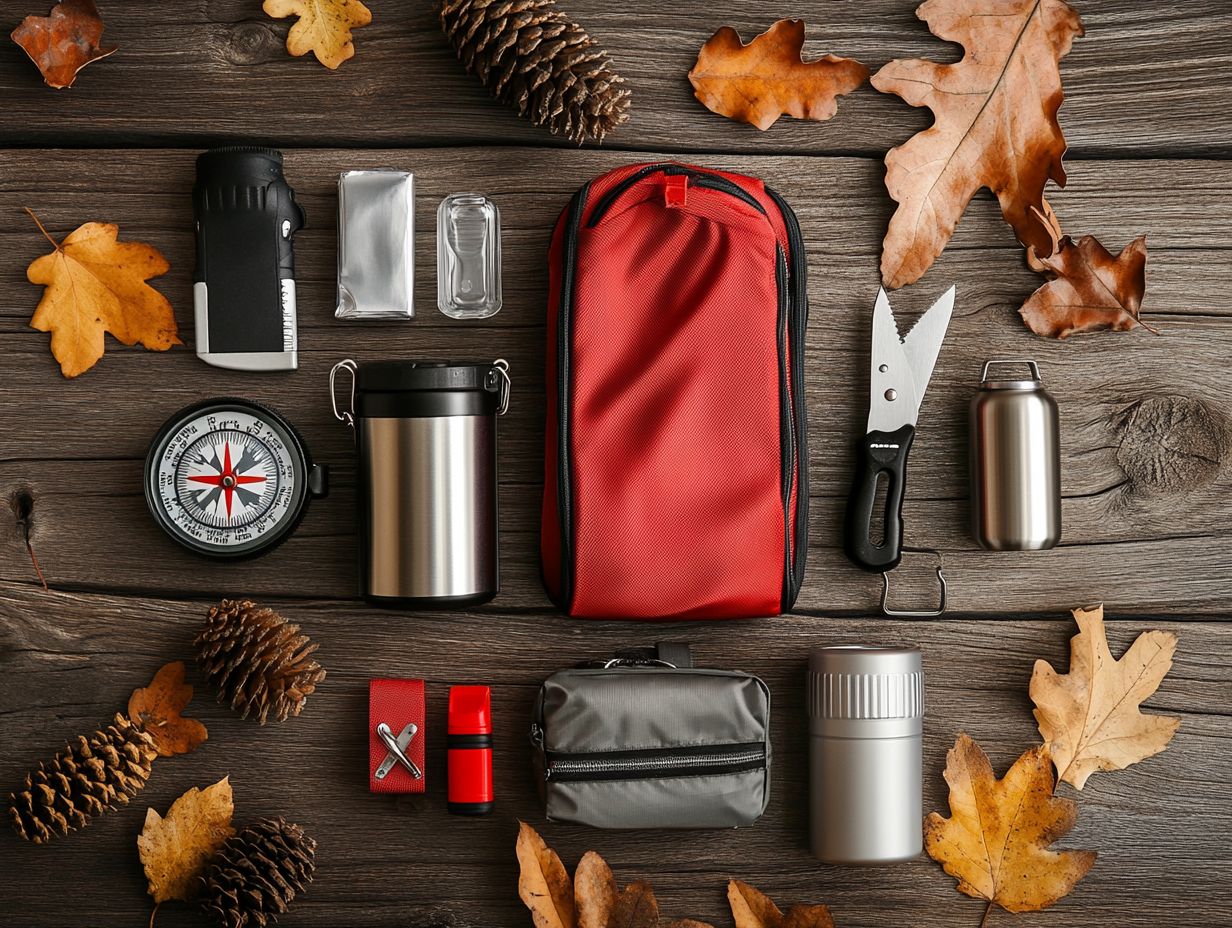
What items should I include in my hiking survival kit?
Some essential items to include in a hiking survival kit are a first aid kit, water purification tablets, a compass, a fire starter, a multi-tool, and emergency shelter.
How much water should I pack in my hiking survival kit?
It is recommended to pack at least 2 liters of water per person per day in your hiking survival kit. This may vary depending on the length and difficulty of your hike.
Should I pack food in my hiking survival kit?
Yes, pack non-perishable, high-energy snacks in your hiking survival kit. Examples include energy bars, trail mix, and jerky.
What should I consider when choosing a first aid kit for my hiking survival kit?
When choosing a first aid kit for your hiking survival kit, consider the length and difficulty of your hike, the number of people in your group, and any medical conditions or allergies that may need specific supplies.
While cell phones can be useful in an emergency, do not rely on them as your primary navigation tool. Instead, pack a traditional compass or GPS device in your hiking survival kit.
Do I need to pack different items for different types of hikes in my survival kit?
Yes, the items you pack may vary depending on the location, climate, and duration of your hike. Research the area and prepare accordingly.

